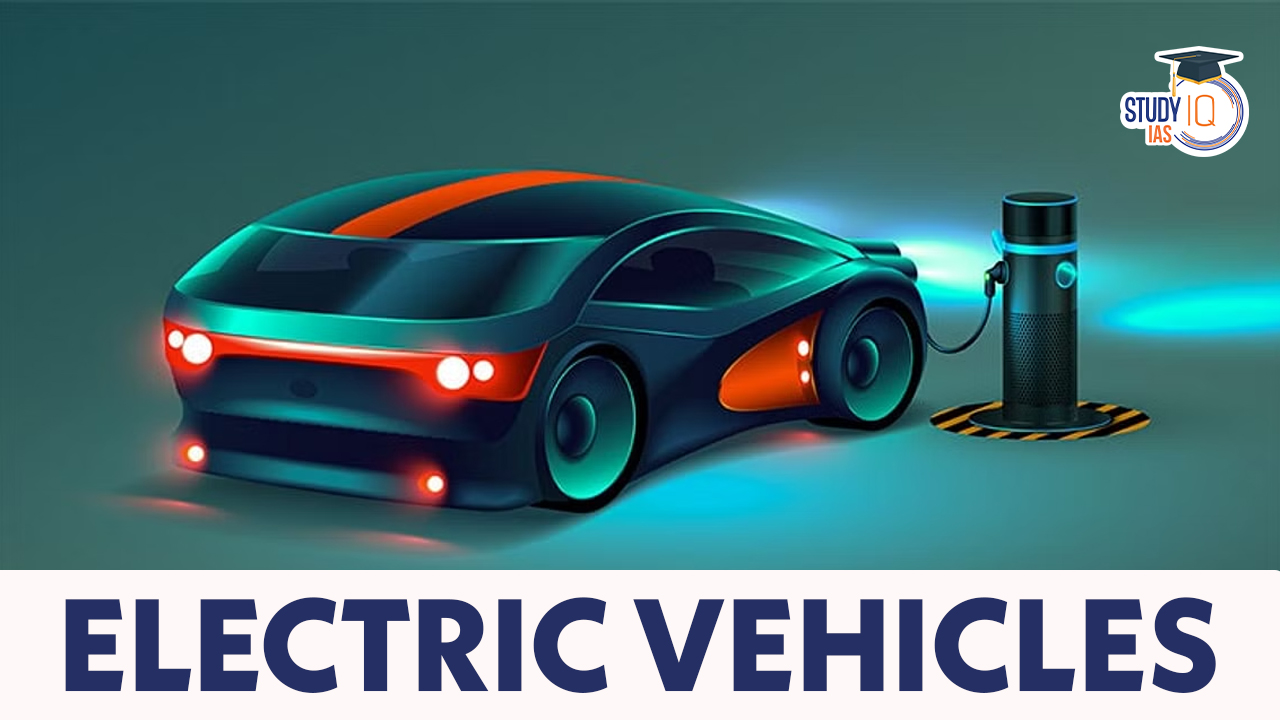Table of Contents
Context: India saw 120 per cent growth in electric vehicles (EVs) in the second quarter of 2023, driven by a 400 per cent surge in hybrid vehicles, according to the report by CyberMedia Research (CMR).
What are Electric Vehicles?
- An electric vehicle (EV) is a type of vehicle that uses one or more electric motors for propulsion instead of an Internal Combustion Engine (ICE).
- EVs can be powered by batteries that are recharged by plugging the vehicle into an electric power source, or they can be powered by a hydrogen fuel cell that converts hydrogen gas into electricity.
- Compared to traditional gasoline-powered vehicles, EVs produce fewer emissions and are more energy-efficient that can potentially save money on fuel and maintenance costs.
Types of Electric Vehicles
There are four types of electric vehicles available:
- Battery Electric Vehicle (BEV): Fully powered by electricity. These are more efficient compared to hybrid and plug-in hybrids.
- Hybrid Electric Vehicle:
- Hybrid Electric Vehicle (HEV): The vehicle uses both the internal combustion (usually petrol) engine and the battery-powered motor powertrain. The petrol engine is used both to drive and charge when the battery is empty. These vehicles are not as efficient as fully electric or plug-in hybrid vehicles.
- Plug-in Hybrid Electric Vehicle (PHEV): Uses both an internal combustion engine and a battery charged from an external socket (they have a plug). This means the vehicle’s battery can be charged with electricity rather than the engine. PHEVs are more efficient than HEVs but less efficient than BEVs.
- Fuel Cell Electric Vehicle (FCEV): Electric energy is produced from chemical energy. For example, a hydrogen FCEV.
Need for Promoting EVs in India
- Reducing Oil Import Dependency: During FY 2022-23, India’s dependency on oil and oil equivalent gas imports is 78.6 percent, underscoring the need to promote EVs to curtail this reliance.
- Improving Air Quality: Vehicular emission is a major cause of air pollution in urban areas. As EVs produce fewer emissions, they can significantly improve air quality.
- Typically, vehicular emission contributes 20-30% of Particulate Matter (PM) 2.5 at the breathing level of air quality.
- At the same time, around 8% of total Greenhouse Gas (GHG) Emissions in India are from the transport sector, and in Delhi, it exceeds 30%.
- As per the ‘World Air Quality Report, 2022’ released by IQAir, 39 of the top 50 most polluted cities in the world are in India.
- International Commitments: Promoting EVs can aid in fulfilling India’s international commitments under initiatives like Panchamrit, aiming for net-zero carbon emissions by 2070 and a billion-ton reduction in carbon emissions by 2030.
Current Status and Prospects of EV Ecosystem in India
- India is the third largest automobile market globally in terms of sales, ahead of Germany and Japan.
- The Economic Survey 2023 predicts that India’s domestic electric vehicle market will see a 49 percent CAGR between 2022 and 2030, with 10 million annual sales by 2030.
- Additionally, the electric vehicle industry is projected to create around 50 million direct and indirect jobs by 2030.
- The Indian government has set a target to achieve 30 percent electrification of the country’s vehicle fleet by 2030.
Steps taken by the Government to promote Electric Vehicles
- E-Amrit Portal: India launched E-Amrit portal (at COP26 Summit in Glasgow) as a one-stop destination for all information on electric vehicles.
- National Electric Mobility Mission Plan (NEMMP) 2020: Launched by the Department of Heavy Industry in 2012, it aims at promoting hybrid and electric vehicles.
- It sets out the target to achieve 6-7 million sales of hybrid and electric vehicles year on year from 2020 onwards by providing fiscal incentives.
- FAME (Faster Adoption and Manufacturing of (Hybrid and) Electric Vehicles) Scheme: It was launched in April 2015 under the NEMMP, to encourage electric and hybrid vehicle purchase by providing financial support.
- Its first phase ran for four years until 2019.
- The second phase (FAME II) is a 3-year subsidy programme. It aims at supporting the electrification of public and shared transportation.
- The programme also finances charging infrastructures.
- GST restructuring: GST on electric vehicles has been reduced from 12% to 5%; GST on chargers/ charging stations for electric vehicles has been reduced from 18% to 5% by GST Council.
- Production Linked Incentive (PLI) scheme:
- For manufacturing of Advanced Chemistry Cell (ACC) in the country in order to bring down prices of battery in the country.
- Auto and Auto component PLI Scheme, hydrogen fuel cell-based vehicles which are Zero Emission Vehicles (ZEVs) are covered under this.
- Guidelines for EV charging infrastructure: The Ministry of Power has issued the revised consolidated Guidelines & Standards for charging infrastructure for Electric Vehicles.
- The guidelines allow the entities or individuals to create charging stations without the need for license. However, they should meet certain technical and safety standards.
- The guidelines allow users to charge their electric vehicles in their respective offices and homes.
- The guidelines have introduced a revenue sharing model for using land. Government lands will be provided to entities interested in installing charging infrastructure.
- The Bureau of energy Efficiency will create an online database of public charging stations.
- The guidelines include action plan for nine major cities. They are Chennai, Pune, Surat, Kolkata, Hyderabad, Ahmedabad, Mumbai, Bengaluru, and Delhi.
- Green license plates: Ministry of Road Transport & Highways (MoRTH) announced that battery operated vehicles will be given green license plates and be exempted from permit requirements.
- Model Building Bylaws 2016: Ministry of Housing and Urban Development amended the law to establish charging stations and infrastructure in private and commercial buildings.
- Several states (including Delhi, UP, MP, Telangana, Andhra Pradesh etc.) have notified their EV policies aimed at promoting manufacturing and increasing demand of electric vehicles in their respective states.
- ISRO has commercialized indigenously developed lithium-ion battery technology and has selected 14 companies for transfer of technology.
Challenges for EVs ad EV Industry in India
- Consumer Deterrents: Consumers are discouraged from adopting EVs due to concerns about limited driving range, safety, uncertain resale value, lack of widespread charging infrastructure, unreliable electricity supply, and the price gap between EVs and internal combustion engine (ICE) vehicles.
- Inadequate Charging Infrastructure: The establishment of charging stations is hindered by low utilization rates, high operational costs, concerns about overloading electricity DISCOMs, and other factors, creating a disincentive for charging station operators.
- Battery Technology Limitations: The battery technology used in EVs is still evolving, and the cost of the battery is a significant factor in the overall cost of an EV.
- Moreover, the availability of rare earth metals and other raw materials required for the production of batteries is limited.
- Limited Manufacturing Capacities: India is heavily dependent on import in EV sector such as rechargeable batteries, equipment, etc.
- Lack of Scrapping Policy: End-of-life disposal of EVs is a concern due to the presence of high-voltage components that can harm the environment if not properly managed.
- Shortage of Skilled Workforce: EVs have unique components and systems, such as batteries, electric motors etc., that require specialized training and expertise to repair and service.
- Cyber Security and Privacy Concerns: The interconnectedness of EVs and personal devices introduces potential threats such as mobile malware, phishing attacks, and data breaches.
Way Forward
- Public charging stations: As EV adoption surges, an extensive public charging network is vital to meet growing power demand.
- An effective solution is repurposing gas stations into hybrid charging stations for EVs.
- Use of renewable energy sources: Incorporating renewables into EV charging boosts economic and environmental sustainability.
- India’s climate advantage can harness solar power to meet rising demands without overburdening the existing power grid.
- Development of fast charging technologies: To enhance the viability of EVs for long-distance travel, the development of fast-charging infrastructure is crucial.
- Fast-charging stations, capable of delivering high-voltage charging, significantly reduce charging time, alleviating range anxiety for EV owners.
- Innovative Payment Solutions: To encourage EV adoption, it is essential to provide convenient and user-friendly payment systems for charging services.
- Additionally, transparent pricing models and subscription-based plans can provide incentives for EV owners to opt for public charging infrastructure.
- Widespread consumer awareness: Organizing public events in the form of educational campaigns, rides, and drives can have a transformative impact.
A Parliamentary Committee on Estimates presented a report titled ‘Evaluation of Electric Vehicle (EV) Policy’ has suggested the following measures:
- National Policy on EVs: The report said, although transport is a state subject and some states have formulated their own EV policies, a “strong National Policy framework on EVs” needs to be formulated.
- Reducing Initial Costs: Lowering upfront expenses by increasing subsidies on electric four-wheelers, encouraging states to exempt road tax, and further reducing GST on EVs.
- Promotion of Diverse Technologies: Promoting a variety of technologies alongside EVs, such as flex fuel vehicles, hydrogen ICE, and hydrogen fuel cell vehicles, with a stronger focus.
- Extending FAME-II: Extending the FAME-II scheme by two years beyond its current deadline of March 31, 2024, and introducing a comprehensive FAME-III scheme based on lessons learned.
- Consumer Trust: Establishing safety standards and offering battery life guarantees to build consumer confidence.
- Skill Development: Creating specialized EV courses in ITIs, Industrial Training Centres, and Skill Development Centres.
- Battery Reuse and Disposal: Implementing a proper plan for battery disposal and establishing dedicated recycling facilities to ensure a sustainable EV ecosystem.
- Lithium Extraction Acceleration: The Geological Survey of India (GSI) has identified significant Lithium inferred resources in the Salal-Haimana area of Jammu & Kashmir, indicating the need to expedite extraction efforts.


 Mantis Shrimp - Latest Research News and...
Mantis Shrimp - Latest Research News and...
 IB ACIO Syllabus 2025, Subject-Wise Exam...
IB ACIO Syllabus 2025, Subject-Wise Exam...
 Rare Earth Elements, Metals, Magnets, Ap...
Rare Earth Elements, Metals, Magnets, Ap...





















